Last updated: April 3, 2024
Article
The Current: Spring 2024
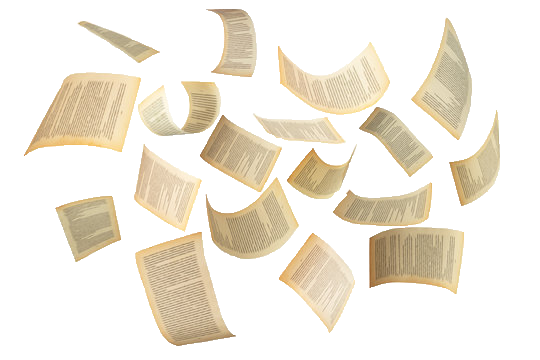
“Science is Not Finished Until It is Communicated”
By Ted Gostomski, Network Science Writer
When I came to the network as a Science Writer, I envisioned writing and producing all kinds of reports and publications including perhaps monographs based on years of work we would do in the parks. I looked forward to working with people to create beautiful works of science that marked the culmination of years of work.
In May of 2020, Noel Pavlovic, a botanist with the U.S. Geological Survey (USGS) based at Indiana Dunes National Park, sent me an email asking about how to publish something in the Natural Resource Report series. The “massive document” had already been reviewed by USGS scientists, which made it seem even easier to accomplish.
Just “provide the names and contact information of those who reviewed it and a very brief statement of what changes you made to the report as a result of the review,” I told him.
Five months later, in October 2020, Noel sent me a “Special Flora and Vegetation of Indiana Dunes National Park,” a Word document that began a process of back-and-forth communication between he and I. Bugs in the system kept crashing my computer when I opened the Word file. We chatted about figure legends, superscripts, and the phylogenetic order of plant lists.
In March of 2021, I sent Noel a PDF to review, writing, “At long last, here is the Special Flora report, almost ready for publication.” I signed off saying, “And congratulations! You now hold the record for the largest report I have ever worked on, passing the previous record holder by 430 pages.”
We seemed to be picking up momentum. I sent the second review copy one month later. Noel submitted this version for a USGS policy review, which is required for all USGS publications and is separate from peer review. Results of the policy review came back in sections. First the Executive Summary in July, then the Introduction in September.
“Attached are the edits to the Introduction,” wrote Noel in September 2021. “I will send you these as they come in. This could be a long process.”
In the meantime, Noel and I were writing back and forth, checking and fixing numbers, adding in figures, and asking and answering all kinds of clarifying questions.
Then, in early November, “In late August, the Bureau Approving Official’s computer crashed and she lost everything.” The Methods and Results sections arrived four days apart from one another in mid-November.
In January of 2022, we assessed our progress and checked in with our respective supervisors about how much more time and effort would be given to this project. Then we pushed forward.
In April I sent Noel a draft of the “Annotated List of Special Flora,” almost 170 pages of profiles for each species. Noel replied, “I will work on getting through your edits by the end of the week. ... I have kept a list of literature to added to the Lit Cited section. ... I will need to check the statistics everywhere one more time. ... I also have some revised figures and a few additional ones.” New figures meant renumbering everything. We would do this a couple of times for the figures and the tables.
May 23rd: We are almost done with the policy review. I am going to start sending you chapters to edit.
I am afraid to say there are a lot of changes throughout. As I feared, perfection in policy review was the enemy of completion. Nevertheless, I am hopeful by the end of June all sections will be approved.
We were working on chapters about each of the study units now, 15 units in all. June passed and the policy review plowed on. Reviewed chapters were coming in groups now. The policy review was completed some time in late fall of 2022, and in November, I sent Noel a new draft copy of the entire report.
In February of 2023, Noel began sending me chapters that one of his co-authors, Gayle Tonkovich, had reviewed. She found mistakes that both Noel and I had missed, but she was working from an older version, so she also noted things we had already fixed. These exchanges continued into July, when Noel signed off an email, “I am desperately trying to get this project completed.” This sentence spoke to a shared, growing exhaustion. Sometime before this, Noel had mentioned to me during a phone conversation that he had been talking to Barbara Plampin, another co-author, and she had said to him, “I’d like to see you complete this report before I die.” Noel paused, “She’s 93 years old, Ted!” In another three months, we would mark two years since we started on this project.
The summer of 2023 was spent making corrections to species lists and tables. In late August, Noel sent me “the final unit chapter statistics edits.” Minor editing continued—a lot of spelling and species designations. Then more changes in numbers. In early September, Noel wrote, “Here is my plan: I will let Gayle finish the edits of the abstracts by Sept 15 so that you can make the final edits and send it to [NPS publication managers] before Sept. 30.” True enough, on September 21st, Noel wrote, “Here are my final edits. You can now wrap it up and send it to the publication folks. Thanks for your patience in this long process.” I submitted the report for publication in the NPS Natural Resource Report series on September 27, 2023.
Beginning on November 10, I began trading emails with the Natural Resource Publications Manager (NRPM) about the massive manuscript I had submitted.
“I need you to send me a PDF version of this report with the changes outlined below before I can go any further,” he wrote. Further down in the email was a header: “Big Required Changes to do in InDesign Before You Export and Send Me a PDF Copy.” This was followed by a list of changes under four sub-headers regarding the main table of contents, headings, tables, and figures. I re-submitted the manuscript with all of the requested changes exactly two months later, on November 27.
December 1, from the NRPM: Are you sure that you want to publish this with us?
This question was followed by another long list of necessary corrections that took up four pages when I printed it.
December 4, from me: This report first came to me in October of 2020, so yes, we are publishing this here. I’ve got way too much time and work into this now to just stop. So, I will take on this list of changes and send you a revised PDF.
Another revised version was submitted on December 8th. That was the last word until January 2024.
January 7 (a Sunday), from the NRPM: Hello Ted. Sorry for the delay on this one and for the long list of instructions below.
The next revision was submitted January 17th.
February 8, from the NRPM: Sorry for the delays on this one. The Four Remaining Steps Are: ...
I completed the four steps and returned the “final PDF” two hours later.
On February 15, 2024, three years, four months, and three days after Noel first sent me a Word document with his manuscript, the NRPM sent me the final email (notably, at 12:01 AM): “This report is now published and available for public download.”
I forwarded the email to Noel at 7:55 AM, and sixteen minutes later, Noel replied, “Wow! I am downloading it now. Such a big report! As if we did not know. I cannot wait to see it. ... Barbara will be so happy – I will phone her today.”
I read a magazine article written in 2015 in which the U.K.’s chief scientific advisor was quoted standing before a gathering in London, “Science is not finished until it’s communicated.” So much data sits in spreadsheets on computers or in file folders on dusty shelves. The final step, required of all scientists who learn new things, is to share what they have learned with others. Noel’s report is a perfect example of this. No matter how long it takes, how frustrated we become, it is incumbent on us to push through and to communicate our science.
Congratulations, Noel, on a job very well done.

NPS photo
Moving On Up...Way Up
Network plant ecologist Suzanne Sanders left the Great Lakes Network in March to become the Natural Resource Program Manager for Katmai National Park and Preserve in King Salmon, Alaska.
Suzy’s NPS career began in 2004, when she was hired in a term position as the network’s Inventory Specialist. At that time, many of the inventories were already underway, so Suzy’s job was to oversee their completion and handle contracting duties. She moved into the plant ecologist position in 2007, when the vegetation monitoring program was begun, but her position did not turn permanent until the following year.
Suzy consulted with many colleagues to develop the in-depth vegetation monitoring protocol that is now used in the Great Lakes Network parks, and over the last 17 years, she has been through two rounds of sampling at each park (an individual park is sampled once every nine years). Early on, she and network botanist Jessica Kirschbaum tried sampling two parks in one year. That turned out to be far too labor-intensive and a real headache when it came to the seasonal crew members having to find housing in two different places over the summer. They stick to one park per summer now. It’s still labor-intensive, but it works very well.
Regarding the value of the vegetation monitoring program, Suzy says, “We gather a lot of information and we can answer a lot of questions about things like the understory plant community and the regeneration of seedlings and saplings. That is where any changes in the forest community will first appear.” It’s that kind of information that Suzy would like to see captured in a data visualizer park managers could use to more easily explore all the information her team has collected.
After 17 years bushwhacking through the network parks, it’s the random sightings of unexpected plants and animals that stick with her the most. She points to a framed photo on her office wall of sundew, a tiny, delicate wetland plant she came across on Isle Royale one year. “Things like that,” she says. Similarly, it’s the tundra plants in Alaska that she is really looking forward to learning in between managing the dozens of projects that resource management staff carry out at Katmai every year.
Thank you, Suzy, and good luck on your new adventure!
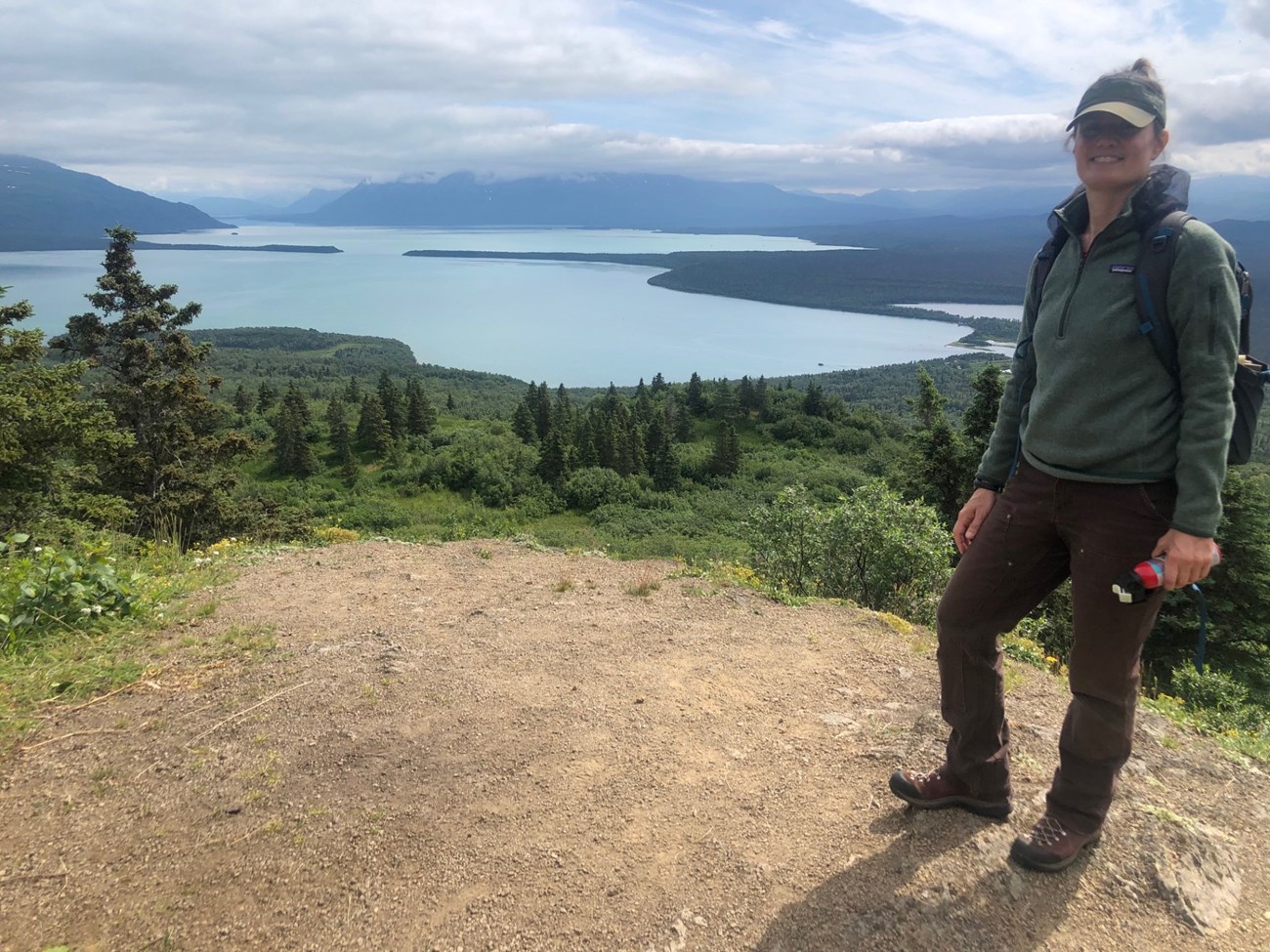
S. Sanders
2024 Field Season Schedule
|
|
Amphibians |
Contaminants (Dragonflies) |
Landbirds |
Vegetation |
Water Quality |
|---|---|---|---|---|---|
|
Apostle Islands |
Mar - Aug |
May - Aug |
June |
n/a |
June - Oct?2 |
|
Grand Portage |
Mar - Aug |
May - Aug |
June |
n/a |
n/a |
|
Indiana Dunes |
Mar - Aug |
May - Aug |
June |
n/a |
May, July, Sep |
|
Isle Royale |
Mar - Aug |
May - Aug |
June |
n/a |
May - Sep3 |
|
Mississippi River |
Mar - Aug |
May - Aug |
June |
n/a |
n/a |
|
Pictured Rocks |
Mar - Aug |
May - Aug |
June |
n/a |
June - Sep4 |
|
St. Croix Riverway |
Apr - Aug1 |
May - Aug |
June |
June - Aug |
Apr - Nov4 |
|
Sleeping Bear Dunes |
Mar - Aug |
May - Aug |
June |
n/a |
June - Sep |
|
Voyageurs |
Apr - Aug1 |
May - Aug |
June |
n/a |
June - Sep5 |
Amphibians — Park and network staff along with volunteers will collect data recordings.
Contaminants (Dragonflies) — Samples will be collected by a Northland College field crew at APIS, GRPO, ISRO, and SACN, and by park staff and volunteers at the other parks.
Landbirds — Surveys are conducted by park staff, volunteers, and contractors.
Vegetation — Conducted with a team of three cooperators led by Jessica Kirschbaum.
Water Quality — Conducted by Josh Dickey (INDU), Alex Egan (ISRO), Tony Vitale (PIRO), Rick Damstra (SACN), Chris Otto (SLBE), and James Smith (VOYA).
1 Monitoring is being conducted using a U.S. Geological Survey protocol.
2 Depends on whether a sandbar has formed/been maintained across the mouth of Outer Island lagoon.
3 Includes sampling for freshwater midges from a subset of lakes.
4 Includes aquatic insect sampling at a subset of sites.
5 Includes sampling for mercury in water from a subset of lakes.
The Art of Science
There are many things that are observed and measured by our water quality monitoring team when they visit a site on either a lake or a river. One seemingly simple observation that is recorded on the data sheet is water color.
Water quality monitoring data collected by all the I&M networks is housed in a database called NPStoret. Aquatic ecologist Rick Damstra was working in the database one day, looking to standardize some of the data entry by creating a drop-down list of choices for water color. To do this, he first pulled up a list of what has been entered over the last 17 years. He found “429 unique ways of describing water color in the NPStoret database!”
“Across all of the NPS?” I asked.
“No, that’s just in our network!”
He shared the list with me. Alphabetically, the colors range from “a little yellow” to “yellowish-green.” Actual colors include two ambers and two beiges, seven blacks, 11 blues, 49 browns, one golden, eight grays, 47 greens, six olives, two oranges, seven reds, 12 tans, one teal, and 45 yellows. There are also 107 clears, two colorless, and one transparent. There are even descriptions of tri-colored water: Greenish yellow and brownish, Yellow greenish-brown, Yellowish brown with a little red tint, and Yellowish green brown.
Then there are the descriptions that begin with modifiers: a little, bright, cloudy, dark, deep, dim, light (the winner at 51 entries), medium, moderate, mostly, muddy, murky, opaque, pale, semi, slight, and very. There are eleven entries describing “stained” water, referring to the brassy, tea-like color derived from tannins leached from surrounding plants (especially cedar trees). There are tints and hues (more of the former than the latter). There is food (“Green – pea soup”) and drink (tea, root beer, and coffee).
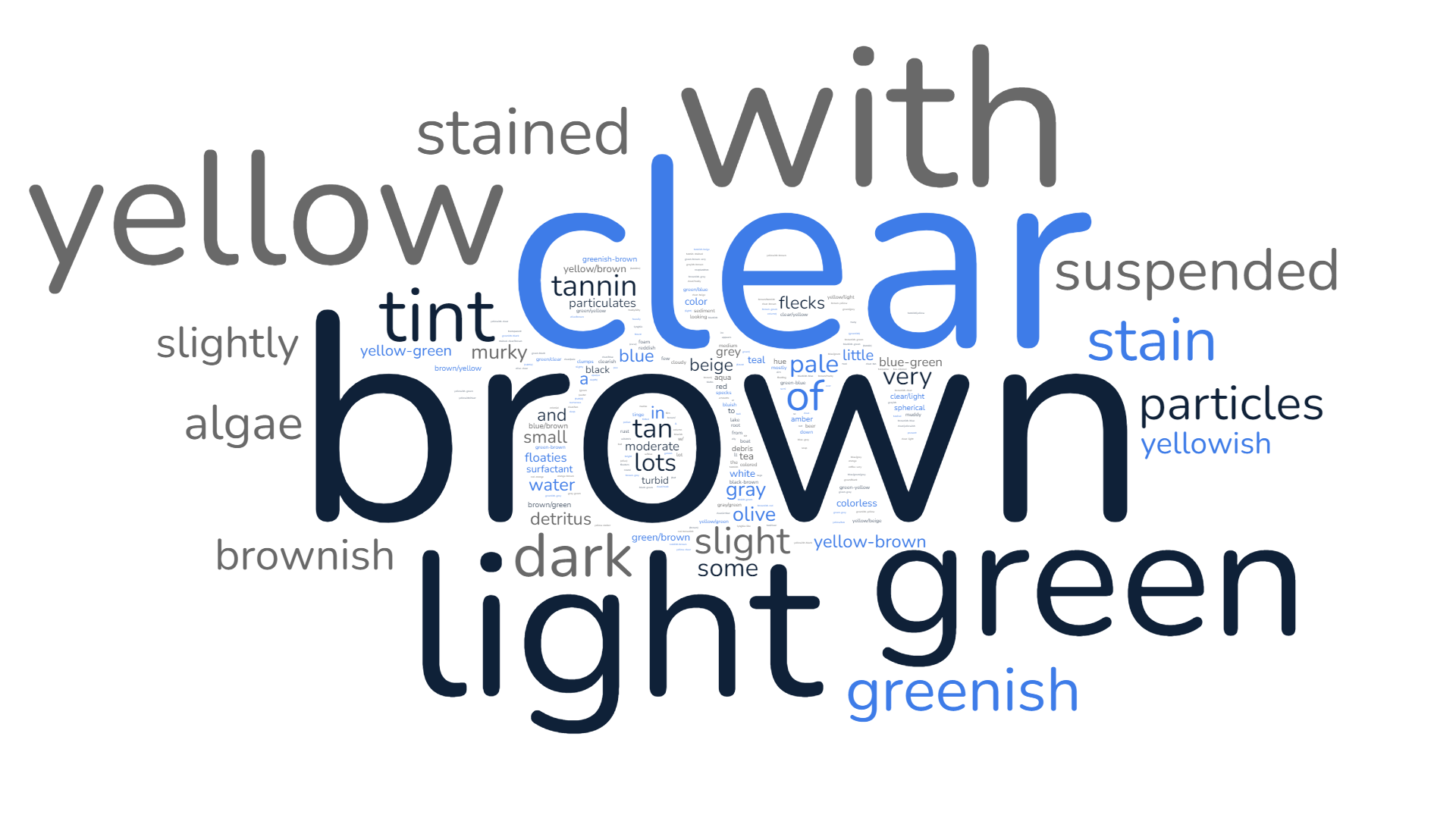
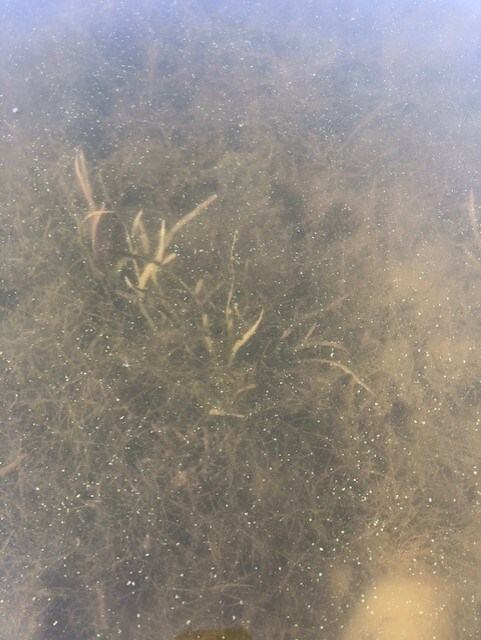
NPS/L. Isbell
It wasn’t just water color. As is spelled out in Standard Operating Procedure #6, field staff are asked to document “General observations on water [that] may include color, unusual amount of suspended matter, debris, or foam.” There are 75 entries about water color that also include information on what was in the water. Among them:
-
A little bit of sediment
-
Algae
-
Blobs of algae
-
Clumps of algae
-
Flecks
-
Light foam
-
Light sediment
-
Light surfactant
-
“Lots of...” debris, detritus, little floaties, particles, small suspended particles, zooplankton and suspended particles
-
Oily film
-
White flecks
Some of the descriptions are very specific, such as “Lyngbia algae” and “Lyngbia-like algae.” These are important notes intended to document the presence of Lyngbya, a blue-green algae (cyanobacteria) that can produce toxins, creating harmful algae blooms (HABs) that make water unfit to drink. Others noted “particulates or colonial algae,” “suspended spherical algae,” and “suspended algae and pollen.” One very descriptive entry even imparted a value judgement: “Clear/murk & floating particulates (eww).”
Children and even adults, when drawing water, use a blue color. Blue is water. But when scientists have to describe the color of water, there is a spectrum of descriptors and modifiers that go far beyond that simple depiction. Some of that comes from the scientific maxim to be specific in describing what you observe. Maybe it also represents a broadening of perspective (consciously or unconsciously). Either way, as Rick later noted after creating the drop-down list to make data entry more standardized, “It feels like something is being lost in the world, but we’ve narrowed it down to 15.”
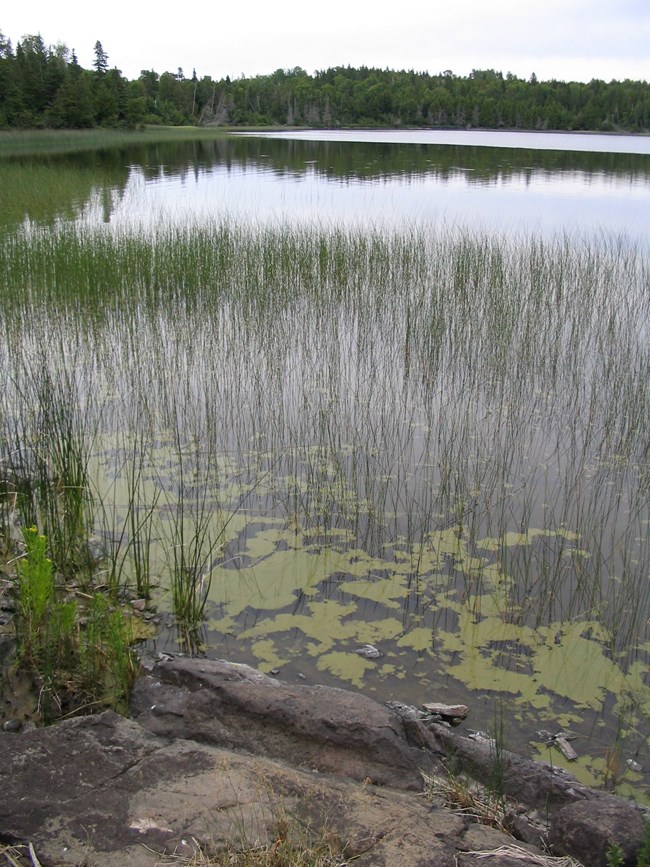
M. Edlund/St. Croix Watershed Research Station
Water Color (choose one)
- Clear
- Brown
- Yellow
- Blue
- Black
- Blue-green (NOT an algae bloom)
- Cloudy green (algae bloom)
- Sediment from runoff
- Clear with particulates
- Brown with particulates
- Yellow with particulates
- Green with particulates (NOT an algae bloom)
- Macrophytes at site
- Foam
- Other
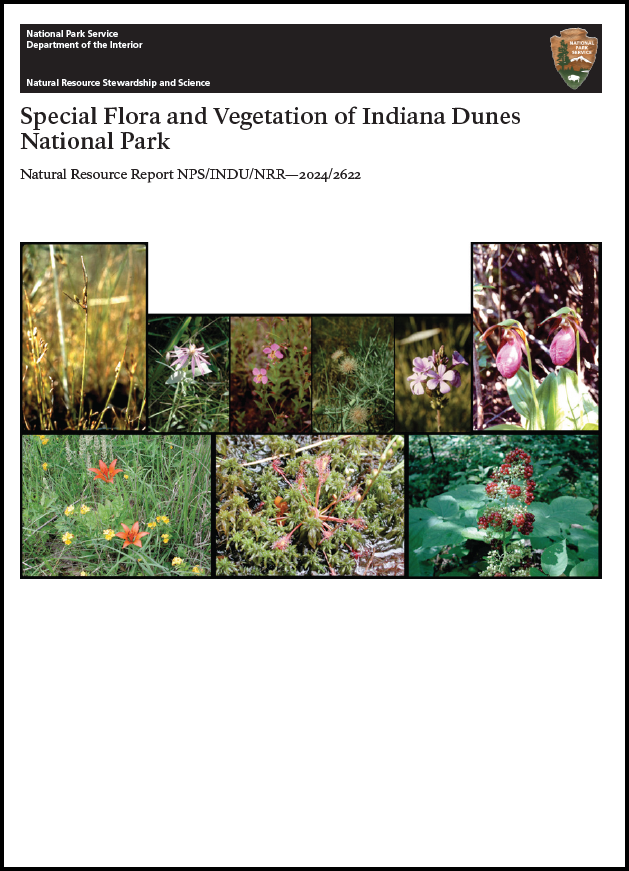
New Reports and Publications
All of these reports can be found on the Great Lakes Network website: www.nps.gov/im/glkn/reports-publications.htm or by using the DOI (digital object identifier). Great Lakes Network staff are indicated in bold blue text.
Pavlovic, N.B., B. Plampin, G.S. Tonkovich, and D.R. Hamilla. 2024. Special flora and vegetation of Indiana Dunes National Park. Natural Resource Report NPS/INDU/NRR—2024/2622. National Park Service. Fort Collins, Colorado. https://doi.org/10.36967/2302417.
Sanders, S., and J. Kirschbaum. 2023. Forest health monitoring at Mississippi National River and Recreation Area: 2022 field season. Natural Resource Data Series NPS/GLKN/NRDS—2023/1400. National Park Service. Fort Collins, Colorado. https://doi.org/10.36967/2301407.

Editor and Web Manager
Ted Gostomski
Thanks to the following contributors: Rick Damstra, Mark Edlund, Suzy Sanders
Tags
- apostle islands national lakeshore
- grand portage national monument
- indiana dunes national park
- isle royale national park
- mississippi national river & recreation area
- pictured rocks national lakeshore
- saint croix national scenic riverway
- sleeping bear dunes national lakeshore
- voyageurs national park
- newsletter
- great lakes network
- apostle islands national lakeshore
- grand portage national monument
- indiana dunes national park
- isle royale national park
- mississippi national river and recreation area
- pictured rocks national lakeshore
- saint croix national scenic riverway
- sleeping bear dunes national lakeshore
- voyageurs national park
- inventory and monitoring division
- science stories
